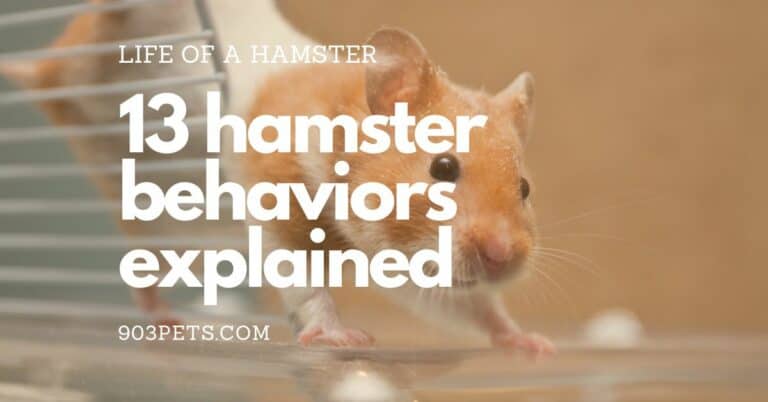What Do Hamsters Eat [Do’s and Don’ts]
You just got your first hamster and the pet store gave you a one-page care guide and you have a bag of food.
Now, how much food are you supposed to feed your hamster? When are you supposed to feed your hamster? Will I feed them too much? And what other treats and snacks can I give the cute cuddly guy?
We’ve got the answers in a quick easy format for you. Don’t forget to check out our calculators when you’re done.
![What Do Hamsters Eat [Do's and Don'ts] 1 What Can Hamster Eat Dos and Donts](https://cdn-0.903pets.com/ifywhoft/2022/01/What-Can-Hamster-Eat-Dos-and-Donts.jpg)
What should I feed my hamster?
What type of food should my hamster eat? Pet hamsters should eat balanced, high-quality hamster food. Feed that is made for rats, guinea pigs, or other animals should not be used. The best hamster foods will have 12-18% protein, 3-6% fats, and should not contain added sugars, artificial flavors, or artificial colorings. Pregnant and nursing females need protein levels up to 24%.
Our Pick For Best Hamster Bedding
Studies and research suggest that paper bedding is best for our hammies. The Carefresh natural paper bedding for small animals is our top pick to use, today.
What We Like:
- Natural paper bedding
- 99% dust free – Reduced cause of respiratory issues for hamsters and human in some cases.
- Up to 10 Days of ammonia odor control
- Good for tunneling and burrowing
- Reduced chance for cuts from sharp portions
- Good absorbency
![What Do Hamsters Eat [Do's and Don'ts] 2](https://cdn-0.903pets.com/ifywhoft/2022/05/Carefresh-Natural-Hamster-Bedding.jpg)
Hamster food is a unique blend made especially for our little hammies. Commercial hamster food brands include Kaytee’s Forti Diet Pro.
What do dwarf hamsters eat? Dwarf hamsters eat the same hamster diet as other species, they just eat less. A portion of standard high-quality hamster food is all you need. However, you should look for food that has smaller pieces since a dwarf hamster is not as large as a Syrian.
Making the task of comparing nutrition and ingredients super simple, our friends at Nibbles and Eats are building a database that you can search. Making decisions on the best food for your hamster takes just a couple of minutes.
How much should I feed my hamster per day?
How much to feed your hamster per day varies based on the size of your hamster. Dwarf hamsters like a Roborovski will eat 1 tablespoon every 2-3 days while a large Syrian hamster might eat 2 tablespoons every other day. On the days you are not feeding them regular food, you can supplement with a 1/2-1 tablespoon of vegetables.
More information is available in How Much Do Hamsters Eat article.
Through observation over time, you’ll find the perfect amount for your hamster using the guidelines above as a starting point.
When should hamsters be fed?
The best time of day to feed your hamster is: anytime. However, being consistent in the timing of your feeds will help your hamster know when to expect food to be available. While hamsters are more active at night, this is to protect them from predators. In captivity, your hamster will still snack during daylight hours, although it may be from the food it stored nearby.
Did you know that some pet hamsters will eat a small bit of food about every 2 hours? Now that is more than a midnight snack.
How often should I feed my hamster?
Hamsters should be fed when their food dish is empty. This means that the time between feedings is based on the speed at which the hamster eats. This rate of feeding a hamster also should take into consideration the size of the hamster versus the amount of food provided.
We do not recommend keeping the food dish full all the time or simply feeding a fixed amount daily. Doing so can lead to your hamster becoming a picky eater, only eating the bits it likes most and leaving the rest to go to waste. This picky eating behavior in hamsters can lead to nutritional deficiencies which can lead to other health issues.
To determine how much and how often to feed your hamster, you will need to be observant. Give your hamster the recommended amount of hamster food in a dish. Then, monitor the dish and determine how long it takes for your hamster to empty it. Do this over the course of two weeks. Review the data you collected and find the average length of time it takes to eat the food.
This becomes the answer to how often and how much should I feed my hamster.
Citrus fruits are dangerous for hamsters and should not be given to them under any circumstances.
903pets.com
Can hamsters eat peanuts or peanut butter?
Yes, hamsters can eat 1/2 of a single food-grade, unsalted peanut no more than once per week. Peanuts should only be fed to hamsters in extreme moderation. Initially start with smaller amounts to test for allergies and stomach upset. Peanuts are high in fats and quickly become unhealthy to a hamster. Peanuts should never be used as a primary food source for a hamster. It is a treat, not the main course.
Another reason to not feed peanuts as an additional treat is that many commercial hamster foods already contain peanuts. So, you could be doubling or tripling their nut intake and the fats contained in them.
In fact, we do not feed peanuts at all to our hamsters because the risks outweigh the rewards when there are plenty of good vegetables they can eat in moderation that have bigger health benefits.
Peanut butter should not be given to hamsters. Most peanut butter is high in salt, sugar, and other ingredients that are unhealthy to a hamster. Nope, don’t do it.
I hear you saying “But I used natural, organic, unsweetened, unsalted peanut butter!” Ok, here’s one other caution about peanut butter.
Peanut butter can get stuck in a hamster’s cheek pouches. When that happens, a hamster will naturally use its front paws to try to move the peanut butter forward and out of its cheek pouches, but peanut butter is sticky. That can lead to impacted hamster cheek pouches which in turn can lead to infection.
If you insist on feeding your hamster the smallest bit of peanut butter, spread a thin layer on a dish or piece of wood so that they are licking it up rather than grabbing chunks of it. This will reduce the chance they will try to store it in their cheek pouches.
Can hamsters eat meat?
Hamsters can eat meat but only sparingly. Hamsters are indeed omnivores, however, that does not mean that meat is a primary food source. A hamster’s natural diet is one that is made up mostly of seeds, grains, fruits, vegetables, and some grassy plants. Meats would only be the occasional insect or worm that your hamster came across.
What types of meat can I feed my hamster? We recommend that if you feed your hamster any meats in its diet, you only use feeder insects, not beef, pork, or poultry. This means occasionally feeding a cricket, super-worm, or mealworm to them. Be careful to remove the feeder insect if your hamster is not eating them. Crickets can actually chew on your hamster given the chance.
Can hamsters eat breads, bagels, or toast?
Bread is made from grains so, I can feed bread to my hamster, right? Not exactly. Yes, hamsters won’t die from eating a little bit of bread. However, bread is not good for hamster health. Bread is high in carbohydrates and offers little nutritional value to hamsters. In fact, a high-carb diet can lead to obesity and nutritional deficiencies in hamsters.
Stay away from the breads even if you hamsters want them.
Can hamsters eat carrots?
Yes, hamsters can eat raw carrots. A small amount of raw carrot as a supplement to regular high-quality hamster food is a good addition to their diet. Portion size is important. Carrots and other treats should never exceed 15% of their normal diet.
Carrots are a source of Vitamin A and Vitamin C which complement each other. Vitamin A helps the body utilize Vitamin C. However, too much Vitamin C will cause diarrhea in hamsters. Because hamsters are so small, diarrhea and quickly turn deadly so again, moderation and slow introduction to foods are important.
Hamsters should not eat cooked carrots. Raw is the right way to do this.
Can hamsters eat celery, lettuce, or kale?
Yes, hamsters can eat celery in moderation, like most other vegetables. Celery has a high water content which can cause diarrhea if your hamster eats too much. Celery is high in fiber which is healthy for your hamster, again in moderation. Only raw celery should be given to hamsters, not cooked celery.
Lettuces are not all good for hamsters.
Yes, hamsters can eat red leaf lettuce, romaine, and curly-leaf lettuce in small amounts. However, iceberg lettuce and other light-colored lettuce should be avoided.
Carrots are a source of Vitamin A and Vitamin C which complement each other. But only feed them to hamsters in moderation, never as a primary diet source.
903pets.com
Can hamsters eat grapes or other fruits?
Yes, hamsters can eat very small amounts of low-acid fruits. Melons, apples (without skin or seeds), and grapes (no seeds) are suitable treats in moderation. Hamsters should not be fed oranges, limes, lemons, or other citrus fruits.
Citrus fruits are dangerous for hamsters and should not be given to them under any circumstances.
Apple seeds are actually dangerous for hamsters. While many sources over-hype the toxicity of apple seeds due to the small amount of cyanide they contain, when it comes to hamsters, this is a real risk. Given the tiny frame, size, and metabolic rate of hamsters, it doesn’t take much of any toxic substance to wreak havoc on their system.
Can hamsters eat cheese?
In extreme moderation and only occasionally, yes, hamsters can eat cheese. Cheese is dense with calories while being a source of protein. The high caloric density of cheese is not healthy for hamsters, especially when there are more nutritious protein options like mealworms available to eat.
So, don’t treat you hamster like a cartoon mouse and feed it cheese very often.
What human foods can hamsters eat that aren’t bad for them?
We know! Our cute little hamster buddies love a good treat. And, it is so easy to think that the treats we adore ourselves would be something our hammie would like too. But, it’s just not the case and in fact, could harm your hamster.
So, what human foods are ok for hamsters to eat? Low acid vegetables, given in moderation, can be fine to give your hamster as a treat.
Believe it or not, one piece of a single kernel of air-popped popcorn can be eaten by your hamster. We’re talking about a treat here and it’s not going to make them healthier. Air-popped popcorn specifically because it cannot have oils, salt, sugar, or anything else on it. Just plain, air-popped popcorn. Be sure to remove the kernel and cool the popcorn before giving it to your hamster
Can you overfeed your hamster?
For hamster treats, fruits, or other goodies, the rule of thumb is to serve them no more than 1 tablespoon in total per week. Break it up however you want. Maybe that’s 1/2 a tablespoon two times per week or 1/4 a tablespoon 4 times per week. The goal is no more than 1 tablespoon total per week. For dwarf hamsters, you might back this rule of thumb down to 1/2 tablespoon of treats per week.
The goal here is to make sure they are getting a nutritionally balanced diet and to prevent obesity which can lead to health problems and a shorter lifespan.
The best hamster foods will have 12-18% protein, 3-6% fats, and should not contain added sugars, artificial flavors, or artificial colorings.
903pets.com
How long can a hamster go without food?
Larger hamsters, like Syrian and Chinese hamsters, should not be left without food or water for more than 3-4 days. Dwarf hamsters should not be left without food and water for more than 2-3 days max.
Much like humans, hamsters can go without food for longer than they can without water.
And like humans, don’t leave your hamster without food and water. If you need to be away for a few days, get a responsible friend to feed and water them until you get back. Be sure to have them over and train them how to do this well.
What foods are bad or dangerous to hamsters?
While we’ve talked a lot about “what can I feed my pet hamster”, it’s just as important to talk about some common foods that you absolutely should not feed your hamster. The following foods are not only items that hamsters should not eat, they are foods that can be harmful or even deadly to our little hamster friends.
Do not feed hamsters:
- Almonds
- Any sugary
- Any salty foods
- Any junk foods
- Apple seeds
- Beans
- Chocolate (No matter what kind)
- Citrus fruits (Oranges, Lemons, Limes, etc…)
- Garlic
- Onions (All kinds)
- Pepper (Black or White)
- Potatoes
- Rhubarb (raw)
- Tomatoes
Hamster Food Menu – Do’s And Don’ts Chart
![What Do Hamsters Eat [Do's and Don'ts] 3](https://cdn-0.903pets.com/ifywhoft/2022/01/Elegant-Two-Column-Bordered-Dinner-Menu-791x1024.png)
Resources / References
- Nibbles & Eats – Easy small pet food facts, ingredients, analysis, and recommendations
- Maryam Hassanpour Moghadam, Mohsen Imenshahidi, and Seyed Ahmad Mohajeri.Journal of Medicinal Food.Jun 2013.558-563. http://doi.org/10.1089/jmf.2012.2664
- National Research Council (US) Subcommittee on Laboratory Animal Nutrition. Nutrient Requirements of Laboratory Animals: Fourth Revised Edition, 1995. Washington (DC): National Academies Press (US); 1995. 5, Nutrient Requirements of the Hamster. Available from: https://www.ncbi.nlm.nih.gov/books/NBK231928/
- Advanced Solutions International, I. (n.d.). Biology Of The Hamster. Biology of the hamster. Retrieved January 15, 2022, from https://lvma.org/LVMA/For_Pet_Owners/Educational_Material/Biology_of_the_Hamster.aspx
If you think your pet is ill, call a vet immediately. All health-related questions should be referred to your veterinarian. They can examine your pet, understand its health history, and make well informed recommendations for your pet.
903pets.com Staff


![How Much Do I Feed My Hamster [Food and Water Guide] 4 How much to feed pet hamsters - food and water guide](https://cdn-0.903pets.com/ifywhoft/2022/01/How-much-to-feed-pet-hamsters-768x402.jpg)

![Hamster Escaped - Where To Find A Lost Hamster Indoors Fast [Statistics] 8 where to find a lost hamster indoors](https://cdn-0.903pets.com/ifywhoft/2022/02/where-to-find-a-lost-hamster-indoors-768x402.png)
![Are Hamster Wheels Safe? [How To Pick] 10 Are Hamster Wheels Safe](https://cdn-0.903pets.com/ifywhoft/2021/06/Are-Hamster-Wheels-Safe-768x402.jpg)

